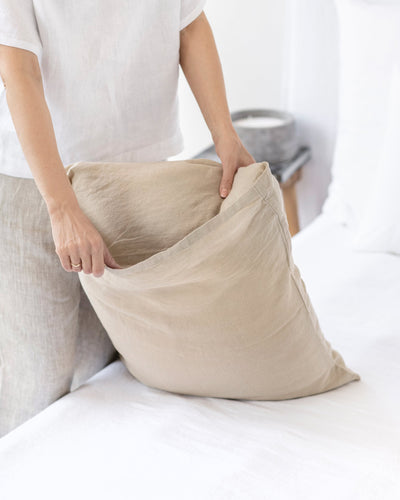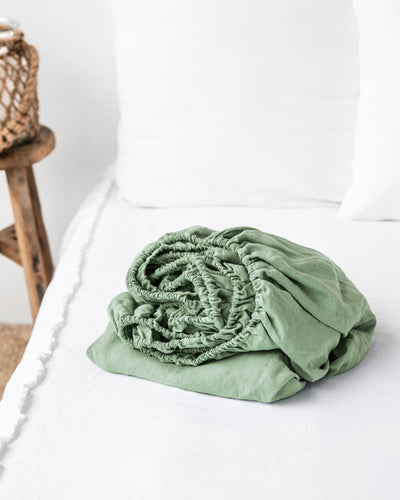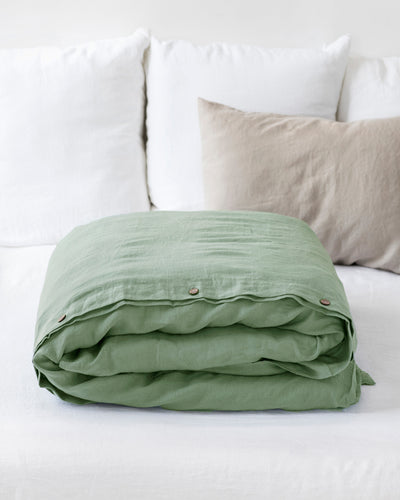Matcha Green: Your New Favorite Bedding Color

We couldn’t be happier to introduce you to our latest - bright, fresh, and Spring-ish - Matcha Green collection!
There are many reasons why our new color is called Matcha green.
First and most obvious to plain sight is the color - it is a beautiful and energetic shade of green, a color that represents the Spring, the revival in nature, and a touch of amazing positive energy in your bedroom.
Second, the more subdued reason is the story and the ceremony of Matcha, which to us represents the harmony, traditions, and craft - the values that inspire our team.
Matcha: Origins and Traditions
Perhaps, the first thing that pops into your head when you hear the word matcha - is tea. And that’s totally right! In recent years, this tea has found the way back to the fancy coffee shops and our tables. But did you know that Matcha tea actually has an incredibly deep-rooted history?
History of Matcha Tea
Matcha tea’s origins lie in China. It was discovered in the 8th century and became viral only four years later - in the 12th century. In the same century - one Buddhist monk - Myoan Eisai imported it to Japan. That’s probably why it is usually mistaken that Matcha Tea was invented by the Japanese.
Production of Matcha Tea: the Bright and Sunny Road
- Japanese Matcha tea is produced from the Camellia sinensis plant leaves.
- The two most significant tea plant-growing regions in Japan are Nishio in the Aichi, and Uji in Kyoto. Leaves for Matcha tea are grown for 3 weeks.
- During the growing process, tea leaves are covered with a special shield preventing direct sunlight to boost the chlorophyll production in leaves. You guessed it right - that’s exactly why the Matcha tea is in such an awesome and bright green color!
- Shading the tea leaves increases not only the production of chlorophyll but also of the theanine - the amino acid element that provides for the tea the specific umami taste.
- Tea leaves are harvested by hand. Later on, they are steamed and dried.
- Afterward, pure dried leaves (called tencha) are grounded into the powder. For this process, a natural stone mill or special pestle is used. Of course, as the demand in the market has increased considerably over the years - special machines are used to ground the tea leaves in order to provide much higher volumes of Matcha Tea Powder.

Just like linen production - the Matcha Tea production pathway takes time, requires special conditions, and lots of patience! Besides, there is no place for any chemicals - both linen and matcha tea manufacturing processes are eco-friendly, 100% natural and focus on the delivery of the highest quality products. And that’s one more very symbolic reason why Matcha green color is so welcome in the MagicLinen family!
The Ritual of Matcha
As you already know, Matcha Tea has been drunk for many centuries now. However, the Matcha Tea Ceremony Ritual was only brought together in the 1500s.
In this century, a Zen student Murata Juko introduced a formal tea drinking ritual that consisted of several ceremony pillars:
- Cultivation
- Consumption
- Ceremony
Juko’s predecessor - Zen Master Sen-no-Rikyu - later contributed to the rapid spread of Juko’s tea ceremony ritual. In fact, he is now known as one of the most important Japanese Tea Ceremony figures in Japan.
Here are the 4 main principles of the Japanese Tea Ceremony:
- Harmony (wa)
- Respect (kei)
- Purity (sei)
- Tranquility (jaku)
This ritual is also called Sado or Chado which means the way of tea.
The Matcha ceremony is the form of art that leaves the attendee good memories - and so this is exactly what we at Magic Linen try to do every day: from sourcing the best linen fabric to sewing it in our own small facility, and delivering it to you across the world - we aim to deliver you the highest quality, comfort, and exceptional care.
Don’t miss out on the joys of life - enjoy the heaven-like sleep quality with the pure linen bedding!
 United States
United States



















